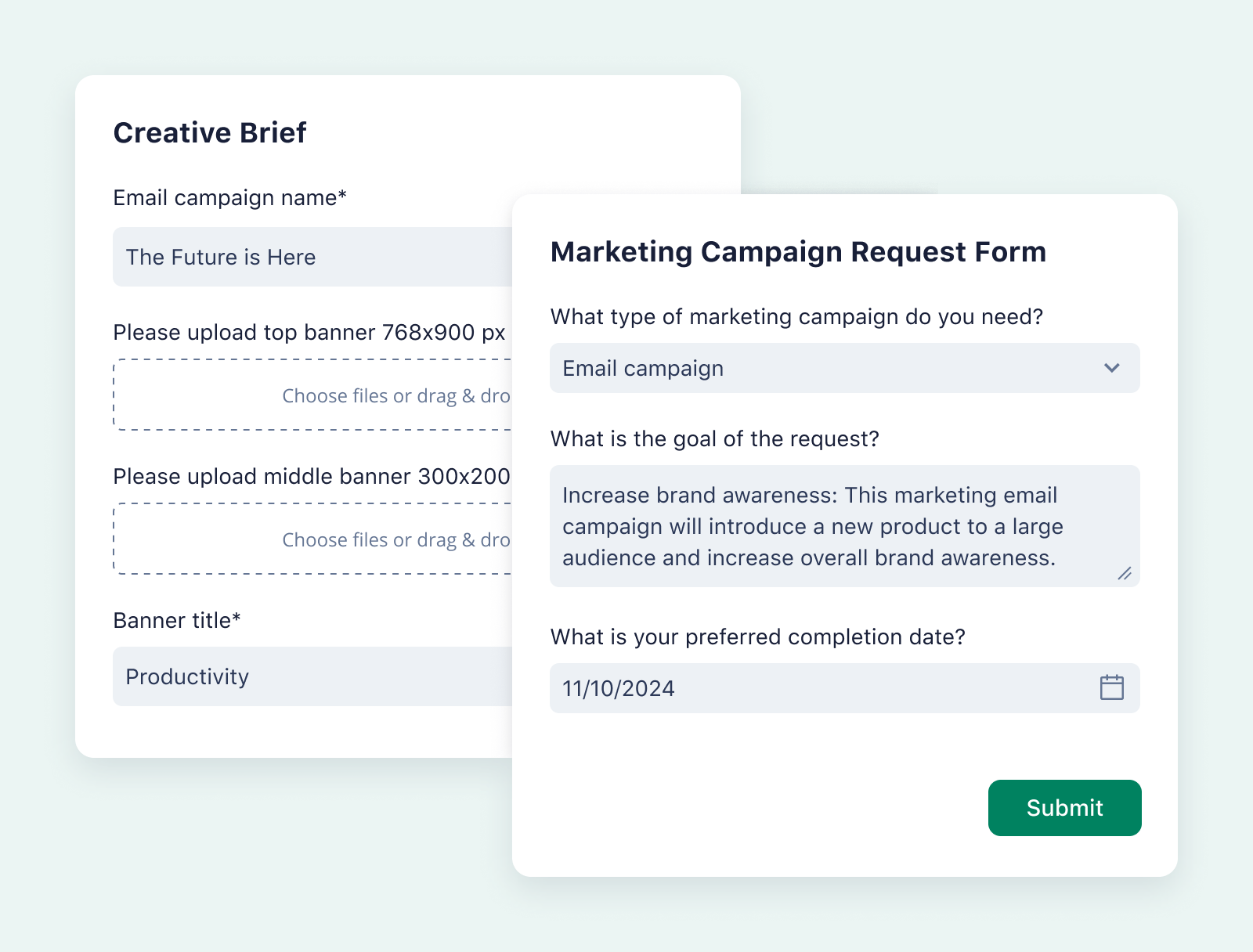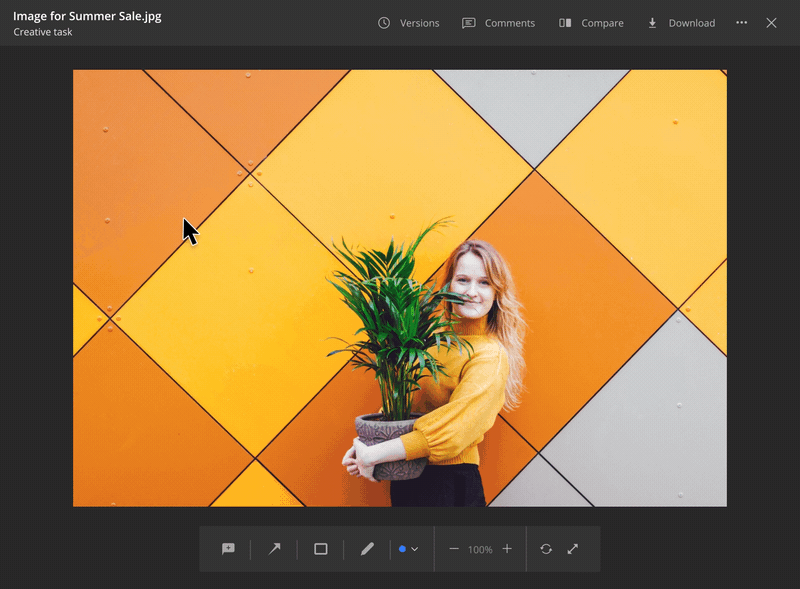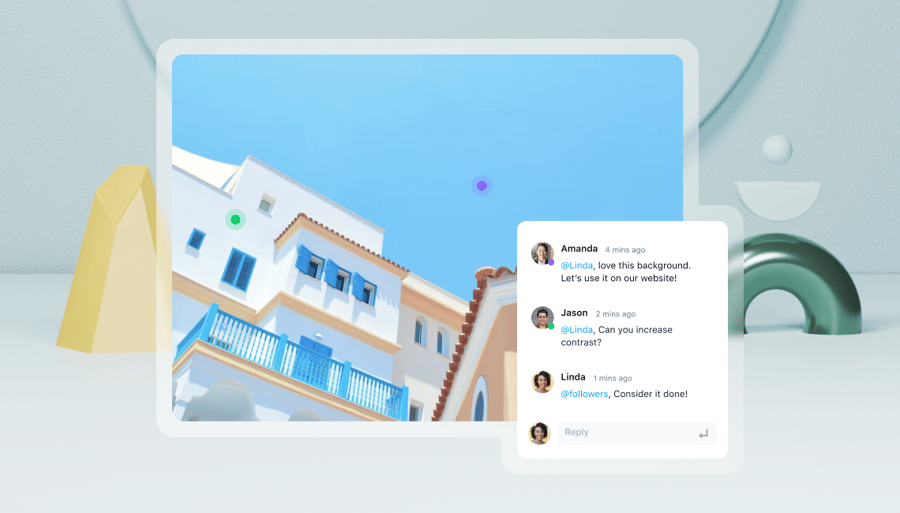Key takeaways:
- What problem does animation project management software solve? It centralizes pre-production, production, and post-production in one workspace — linking storyboards, assets, tasks, dependencies, owners, and deadlines so nothing goes missing between teams.
- How does it speed up feedback without derailing creative flow? With frame-level, in-context comments, robust version control, and structured approvals, stakeholders can review the exact frame, compare versions side by side, and sign off faster.
- What visibility do producers get to keep delivery dates realistic? Live dashboards show shot/scene status, workloads, bottlenecks, risks, and milestones; automations trigger next steps on approval to keep the pipeline moving.
Managing animation projects can be a challenge due to the number of specialists involved at each stage. Teams collaborate on storyboards, assets, and renders, and projects typically require multiple rounds of precise frame-level iterations and feedback before final approval.
The concern for many teams is that most project management software isn't built for the unique demands of animation production. Traditional tools don't offer specific features focused on creativity, such as visual asset tracking, version control, and real-time feedback on scenes. As a result, studios often end up using various third-party solutions, which only slow down production and create internal confusion about ownership and deadlines.
Creative teams need dedicated animation project management software that supports their entire workflow. The right platform should make it simple to assign tasks, share large files, track dependencies, and collaborate on every frame.
In this guide, we'll show you what to look for in animation project management software, how Wrike helps streamline production pipelines, and which other tools are worth considering for studios and creative teams.
6 advantages of centralizing your animation project management
Animation teams require extreme precision — far more than most other creative teams — so they need project management software that supports frame-level accuracy and granular, pixel-accurate feedback.
In typical video production, teams often work in 5–20 second segments, leaving some leeway for timing and fewer revisions. But in animation, teams work frame-by-frame because a single off-frame can disrupt the timing of an entire scene.
For example, if a character's hand misses a cue in a fight sequence, it can throw off the pacing and continuity of the shot. Fixing this usually requires multiple rounds of feedback across animators, compositors, and editors.
Coordinating all these details across different teams and departments is challenging without a centralized project management software. With the right system, the advantages include:
- Centralized storyboards and references: Keep storyboards, concept art, and shot lists in one place so layout and animation teams can easily hand off work without confusion.
- Clear task ownership and dependencies: Assign milestones to specific artists and define which shots or assets must be finished before the next phase begins.
- In-context creative feedback: Collect frame-by-frame comments directly on assets instead of scattering notes across chats and email threads.
- Organized asset storage: Store large renders, textures, and compositing files alongside their related tasks so teams always know which version is final.
- Real-time visibility for producers: Track progress and resource utilization across the entire timeline to identify bottlenecks early and maintain realistic delivery dates.
- Streamlined client reviews: Invite external partners or directors to review and approve scenes within the same workspace, without exposing internal folders or messages.
Wrike gives teams a single, shared workspace to organize projects, track progress, and communicate more effectively. It helps creative studios manage complex workloads with greater visibility and structure, without getting in the way of the creative process.
Next, we'll look at how Wrike's core features can help animation teams plan, collaborate, and deliver their projects more efficiently.
How to manage animation projects with Wrike

Animation producers, program managers, and creative directors don't need to be reminded how the production pipeline works. The real challenge is keeping pre-production, production, and post-production connected, especially when every asset, render, and revision must align perfectly to stay on schedule.
Because animation is such an iterative process, even a single missed note or outdated file can cause issues across departments and delay an entire sequence. The same happens with review cycles that drag on without proper proofing tools, version sprawl that hides the latest render, and unclear ownership that causes work to overlap.
And since teams like animation, lighting, compositing, and sound often work in parallel, a late handoff or missing dependency can quickly lead to missed deadlines.
Wrike solves these problems by unifying all three production stages so that planning, creative work, and delivery remain connected from start to finish.
Here's how it works:
Stage 1: Pre-production
During pre-production, teams develop scripts, design characters and environments, and create storyboards or animatics to define how the story will unfold. This is a stage of heavy coordination between directors, producers, writers, and artists. And it's also where early miscommunication can cause issues later on during production.
The challenge for most studios is keeping this early work aligned. For example, when you create a brief, it often starts as a rough idea, like a few references, a rough script, or a style guide link. From there, storyboards, character designs, and early animatics start coming together.
But without a centralized system, these pieces get stored across email threads, drives, and internal chat apps. One missed update can leave a storyboard artist working from the wrong draft or a designer spending hours on a version that's already been replaced.
Wrike helps creative and production teams stay organized from the start.
- Capture complete creative briefs: Use dynamic request forms to collect all the right details upfront — including project type, animation style, duration, deliverables, references, and deadlines — so nothing slips through.

- Map out dependencies and milestones: Plan scripts, storyboards, and animatics on Gantt charts to show how each phase connects and what must be completed before modeling or rigging begins.
- Centralize storyboards and concept art: Keep scripts, visual references, and early moodboards in shared folders so every department pulls from the same source of truth.
- Streamline collaboration: Review boards, animatics, or reference clips directly inside Wrike using proofing and annotation tools. This way, notes stay with the asset rather than being lost in separate documents or chats.
- Automate setup for recurring projects: Build blueprints for standard animation types, such as product explainers or social shorts. When a new request form is submitted, Wrike will generate the complete pre-production task list automatically.
One of the most valuable releases of 2025 is Wrike Whiteboard, which gives teams a fully integrated space for creative exploration during pre-production. Powered by Klaxoon, Whiteboard empowers studios with an infinite visual canvas where they can build storyboards, craft moodboards, develop early scene concepts, and collect reference materials in one digital workspace. Artists, directors, and producers can drop in images, sketches, notes, and short video clips, and then refine ideas together in real time — all before a single frame of animation is created.

In addition to simplifying early visual development, Whiteboard works as a flexible creative library for casting references, prop ideas, location inspiration, set design notes, and other production-related assets. Because it lives securely inside the Wrike project structure, teams never lose context or alignment as they move from ideation into production. So that means no more lost headshots, forgotten contact details, or long-buried prop lists. Everything stays easily accessible throughout the project and beyond.
The beauty of Wrike is that it brings all creative work into one workplace, giving both artists and producers clarity before production begins. Next, let's look at how Wrike supports teams as they move from planning into active animation and production.
Stage 2: Production
Once pre-production is complete, the animation process moves into full production. This is where storyboards come to life through modeling, rigging, animation, lighting, and compositing.
During production, multiple departments often work on interconnected scenes simultaneously. If one task is missed or falls behind, such as a character rig taking longer than expected, it can delay animation or compositing downstream. With so many dependencies, keeping teams aligned is one of the biggest challenges for any studio. Then, once you add client feedback, last-minute creative notes, and frequent version changes, it's easy for production schedules to fall behind.
Wrike gives producers and creative leads a single command center to manage all these moving parts. This makes it much easier for teams to track progress, dependencies, and resource loads in real time.
- Each active shot or scene, color-coded by status (“In progress,” “Awaiting review,” or “Ready for render”)
- Assigned team members and current workload across departments
- Task dependencies, showing which scenes rely on upstream work like rigging or layout
- Risk indicators for overdue or blocked tasks
- Upcoming milestones and render delivery dates
These live dashboards update automatically as artists mark work complete. This allows producers to monitor an up-to-date view of the entire pipeline without constant back-and-forth.
Another thing Wrike does exceptionally well — fixing a problem that often slows down production teams — is managing review cycles and creative approvals. Animation projects can involve dozens of micro-revisions per scene, and when feedback arrives without context, progress can slow down significantly. Wrike is able to turn those review loops into structured, visual workflows.
Supervisors and clients can leave frame-accurate comments directly on renders, attach visual references to notes, and track every version in one timeline. This means less guesswork, faster turnarounds, and a clearer handoff between animation, lighting, and compositing teams.
Additionally, Wrike can do more for production teams than just managing tasks and feedback:
- Keep assets organized: Wrike's file management system automatically tracks version history and stores each iteration in shared folders. Everyone can access the latest approved version while maintaining a clean archive of earlier drafts.
- Automate routine updates: Approved shots can automatically trigger the next task, alert the compositing team, or update project status. This minimizes manual updates and keeps the pipeline flowing as scenes move toward completion.
- Monitor workloads in real time: Producers can see exactly who's working on which scenes and adjust workloads instantly when schedules shift or priorities change.
Wrike makes the creative workflow the primary focus while simplifying the surrounding processes, such as updates, scheduling, approvals, and version tracking.
Stage 3: Post-production
Post-production is where animation projects come together and the final story takes shape. Once rendering is complete, teams move into compositing, color correction, sound design, and final delivery.
Even at this late stage, animation projects can remain highly iterative. Directors and clients often request micro-adjustments to timing, effects, or color grading. Without a structured review process, this back-and-forth can consume days and blur version history across teams.
Wrike simplifies post-production by keeping all assets, versions, and approvals connected in one place.
Streamlined reviews with frame-level precision
Wrike's online proofing software allows teams to comment directly on frames of a render or composite. Instead of sending notes separately via spreadsheets or timestamped messages, animators and producers can pinpoint an exact frame, such as noting where an effect flares too brightly or a transition feels one frame off. This level of detail turns review cycles into clear, actionable feedback. Within the proofing workspace, users can:
- Add visual annotations directly on the render (e.g., arrows, boxes, or highlights) to mark exactly what needs adjustment
- Tag teammates and reviewers so comments automatically notify the right person, keeping conversations tied to the scene instead of across different tools
- Compare versions side by side to track how changes evolve from one iteration to the next without leaving Wrike

Seamless creative integrations
Wrike integrates directly with the Adobe Creative Cloud, allowing animators and editors to send playblasts, previews, or stills from After Effects, Premiere Pro, or Photoshop straight into Wrike for review. This keeps creative feedback linked to the actual source files without requiring exports, uploads, or separate requests for notes. With these integrations, teams can:
- Share renders instantly from Adobe apps into Wrike's proofing workspace without leaving their creative environment
- Sync feedback directly to the relevant scene or project task, keeping production and creative tools aligned
- Reduce redundant uploads by centralizing every asset and version inside Wrike for easy reference later
Organized version control and asset management
Wrike's file management system automatically tracks version history and stores each iteration in shared folders, giving studios a reliable single source of truth for every shot and render. This organization helps teams:
- Avoid confusing filenames (like scene04_final_v8_fixed_v3) by maintaining clean, traceable version records
- Access the latest approved render instantly while keeping older versions safely archived for reference
- Enable quick comparisons between drafts to evaluate creative changes or restore previous edits if needed
Custom approval workflows
Studios can use Wrike's workflow automation to create structured approval paths that match their hierarchy (director → producer → client). This can keep sign-offs consistent and transparent throughout the project. Within Wrike, approval automation can:
- Automatically notify reviewers when a task reaches their stage, reducing manual follow-ups
- Update task status in real time once a shot is approved or rejected
- Trigger next steps such as routing final renders to delivery folders or alerting downstream teams when assets are ready

Learn how Wrike can help your animation and creative teams today.These tools help carry your animation project smoothly from final render to delivery. Wrike brings every piece of post-production into one connected workspace. And because it's built as a complete animation project management platform, you can continue managing revisions, client deliveries, and future episodes or campaigns long after your final render is complete.
4 additional animation project management software solutions
1. Ftrack
Ftrack is a project management and production tracking platform built specifically for animation, film, and VFX studios. Teams can use it to manage assets, track progress across departments, and simplify creative reviews.
Features
- Manage production schedules and shot progress through visual dashboards and timelines
- Centralize communication between artists, producers, and supervisors
- Use Ftrack Review for real-time annotation and frame-accurate feedback on shots and renders
- Integrate with creative tools such as Maya, Nuke, and Unreal Engine to synchronize task data with production files
2. ProofHub
ProofHub is a creative project management and collaboration tool that helps teams plan, communicate, and review assets. Creative departments and studios can use the platform to efficiently manage large volumes of content and feedback.
Features
- Plan and schedule animation projects with calendar and Gantt chart views
- Collaborate in real time with discussion boards, task comments, and team announcements
- Review and approve creative assets using built-in proofing tools
- Create custom workflows with visual “board” views
3. Frame.io
Frame.io is a collaboration platform built for creatives to organize, review, and share visual assets. It supports the entire animation process from concept through final delivery.
Features
- Upload virtually any asset (animation, 3D render, video, image) and store it securely in one workspace
- Comments and annotations let stakeholders give feedback directly on a frame
- Manage versions and workflows with metadata tagging and flexible folders
- Integrates with creative tools like Adobe Premiere Pro and Adobe After Effects
4. Trello
Trello uses a visual board-and-card system that is intuitive for creative teams managing tasks, assets, and review workflows.
Features
- Organize tasks and assets using boards, lists, and cards
- Easily attach files, links, comments, and due dates to cards
- Automate repetitive workflows with built-in “Butler” rules or Power-Ups
Simplify your animation project management with Wrike
Animation projects are complex, but Wrike makes it easier for creative teams to stay organized, collaborate efficiently, and deliver high-quality work on time. With Wrike's all-in-one workflow management platform, you can:
- Keep every team aligned across pre-production, production, and post-production
- Manage all assets, feedback, and approvals in one shared workspace
- Reduce the number of delays caused by missed updates or version confusion
- Automate recurring tasks and approval workflows to keep projects moving forward
- Deliver polished, on-time results without sacrificing creative flexibility







